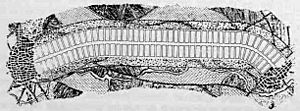Linear city model facts for kids
A linear city is a special way of designing a city. It's a model in modern urban planning, which is like planning how cities are built and organized. This idea was first created by a Spanish planner named Arturo Soria y Mata in 1882. He wanted to build cities that were different from the crowded, dirty industrial cities of his time.
Contents
What is a Linear City?
A linear city is shaped like a very long, narrow strip. Imagine a city that stretches out in a straight line instead of spreading out in all directions. The main part of the city is usually a central road or railway line. All the houses, shops, and other buildings are built along this main path.
How is it Different?
Most cities grow outwards in a circle or a messy shape. A linear city is designed to be simple and easy to expand. You just add more sections to the end of the line. This design helps keep things organized and makes it easier to get around.
Who Invented the Idea?
The idea of the linear city came from Arturo Soria y Mata. He was a Spanish urban planner and engineer. He lived from 1844 to 1920. Soria believed that cities should offer a better quality of life for everyone. He thought that traditional cities were too crowded and unhealthy.
Soria's Vision
Soria dreamed of a city where people could live close to nature. He wanted homes with gardens and fresh air. He also wanted good transportation for everyone. His linear city plan aimed to combine the benefits of city life with the peace of the countryside.
Why Build Linear Cities?
In the late 1800s, many cities were growing very fast because of the Industrial Revolution. This led to big problems like:
- Overcrowding: Too many people living in small spaces.
- Pollution: Factories made a lot of smoke and dirt.
- Poor health: Diseases spread easily in crowded, unsanitary areas.
- Lack of green spaces: Not enough parks or natural areas for people to enjoy.
Arturo Soria wanted to solve these problems. He believed a linear city could offer a healthier and more organized way of living.
How Does a Linear City Work?
In Soria's plan, the main road or railway would run down the middle. On either side of this main path, there would be:
- Houses: Each house would have its own garden.
- Green spaces: Parks and open areas would be close by.
- Services: Shops, schools, and hospitals would be easy to reach.
This design meant that everyone would be close to the main transport line. It also meant that everyone could have access to fresh air and nature.
Where Were They Built?
The most famous example of a linear city was built in Madrid, Spain. Arturo Soria started building it in 1894. It was called the "Ciudad Lineal" (Linear City).
- It had a central tram line.
- Houses with gardens were built along the tram line.
- The project aimed to be a model for future city growth.
While Soria's full vision wasn't completed, parts of his linear city still exist in Madrid today. The idea was also explored in other places. In the 20th century, some planners in Germany and the Soviet Union were interested in linear city concepts for their own urban designs.
Good and Bad Things About Linear Cities
Like any city plan, linear cities have their good and bad points:
Good Points
- Easy to expand: You can just add more sections to the end.
- Good transportation: Everyone is close to the main transport line.
- Access to nature: Homes can have gardens, and green spaces are nearby.
- Simple layout: Easy to navigate and understand.
Bad Points
- Long distances: Getting from one end of a very long linear city to the other could take a long time.
- Limited connections: It might be harder to travel across the city, only along its length.
- Monotony: Some people might find the straight, repetitive layout boring.
Even with these challenges, the linear city idea was an important step in thinking about how cities could be planned differently. It showed a new way to combine city life with a healthier environment.
Related pages


